National parks - challenge exercise: summary analysis
Summary analysis of contributions made to the 'Future for National Parks in Scotland' challenge exercise, May to June 2022, on our public dialogue platform www.ideas.gov.scot.
3. Analysis of Ideas and Comments
This section contains a more detailed analysis of the views expressed against each theme.
The Dialogue consultation elicited a wide range of ideas relating to the criteria for selecting areas to be designated as Scotland's next National Parks. It also generated a wide range of ideas and comments about the powers and functions of National parks in Scotland. This section provides an overview of these comments, grouped by common themes. As might be expected from this topic, many of the themes are reflected in more than one subject area.
The charts in sections 5-12 show the total number of comments related to each theme.
Throughout this section, the term 'National Park' has often been abbreviated to 'NP'.
3.1 Criteria, value and location/type of park
The topics in this section attracted a large number of comments, featuring the highest engagement of all the categories in this report.
Criteria
Ideas and comments in this category broadly fell into two groups:
- Suggestions for the general criteria to be used to decide the location of a new National Park;
- Arguments in favour of one or more specific areas being suitable for a National Park. For the purposes of this analysis, and to ensure impartiality at this stage of the process, these comments have been grouped together and generalised.
The most frequently expressed views were that the chosen location:
- offered something unique or complementary to the existing National Park (NP) portfolio, was in a part of the country which didn't currently have an NP, had a strong narrative or cultural heritage linked to its landscapes, and combined the current NP aims to conserve and enhance the natural and cultural heritage of the area whilst promoting the understanding and enjoyment of the area;
- contained a variety of high quality habitats, ecosystems, beautiful scenery, biodiversity, coastline and/or geology or was of "outstanding national significance for natural beauty, biodiversity, cultural heritage or landscape";
- was easily accessible - either from Scotland's existing population centres, for tourists travelling from other parts of the British Isles, or for those who cannot easily access the existing NPs – with good transport links, or the capability to upgrade existing links;
- be able to demonstrate strong local support from residents, communities, businesses and/or local authorities;
- be able to find a compromise between the key aims of NPs, including balancing the protection of nature with sustainable economic/social development, tourism and land use;
- could support and build on existing environmental designations in the area;
- ensure that NP designation meets the specific needs of an area, addressing a genuine socio-economic or demographic need, or a need that cannot otherwise be met;
- can provide a good variety of recreational/outdoor activities, cycling and walking routes, and cultural or historical attractions;
- has good infrastructure/facilities, and the ability to cope with an increased number of visitors.
Some commenters suggested that the decision should be based on which area most closely met all the existing conditions for NPs, while others expressed doubts that a specific proposed location, or any area in Scotland, met the existing conditions for NP designation.
There was also some debate as to whether the existing NP conditions were adequate, or whether this exercise should be seen as an opportunity to update/expand the criteria to help tackle the biodiversity and climate crises, and encourage innovative approaches. Some commenters cautioned against making the criteria too broad, or recommended following good practice examples from overseas NPs and models of land ownership/management. Specific suggestions for criteria included:
- "Distinctive and coherent character" / "Distinctive character and coherent identity";
- an identifiable cultural or natural heritage at risk;
- land management patterns which demonstrate harmonious interaction between people and nature (drawn from IUCN Protected Area Management Category V - Protected Landscape/Seascape);
- opportunities for appropriate/small scale public enjoyment consistent with conservation;
- a suitably large area;
- potential for integrated management;
- the area's potential for addressing nature recovery.
Value and benefits
This section summarises views provided on what people value about National Parks, and the benefits, or potential benefits, that NP designation can bring to an area.
The most commonly expressed views about the value or benefits of NP designation included:
- boosting the local economy and businesses, increasing income from tourism and hospitality sectors, providing jobs (including skilled jobs) for young people or working age families, regenerating deprived areas, and increased recognition from the internationally known 'kitemark' of NP status;
- helping to protect nature and biodiversity, landscapes, peatlands, forests, marine areas and other ecosystems, tackling climate change and promoting best practice in conservation or acting as exemplars;
- additional resources to address existing visitor management problems, improve infrastructure and/or modernise and upgrade public transport;
- working in partnership with regional economic agencies to support regeneration (although some commenters also stated that NP designation was unnecessary where a region already had a dedicated economic agency);
- encouraging sustainable and responsible land use, and ensuring commercial interests don't override sustainability;
- encouraging and promoting sustainable and responsible access to nature, with associated benefits to mental and physical health (noting that our understanding of this has improved since the original NP legislation was drafted), helping to connect people with nature or providing educational opportunities;
- helping to implement land reform, giving communities greater control over land management or providing a forum for local input into decision making;
- reviving or promoting traditional/indigenous industries or crafts;
- providing added value/generating more income than it costs to run/the economic benefits of NPs are proven.
Location and type of park
While the Scottish Government did not directly seek views on the possible location of new National Parks as part of this consultation exercise, a significant number of ideas and comments provided suggestions or support for a specific location for a new National Park. In approximate order of the frequency of mentions, location suggestions for a traditional park included: Galloway, Scottish Borders, Glen Affric, Lomond Hills/Loch Leven, all of Scotland, the Southern Uplands/all South Scotland, Perthshire, Flow Country, Glencoe/Lochaber, Highlands, Carron Valley, Fife, the area between the M8/M9 corridor, the route of the NC500, the Ochil Hills and the Pentland Hills.
Some ideas and comments also provided suggestions or support for a particular/novel type of National Park. These included:
- a marine/coastal/islands park or addition of an area of sea to an existing or new terrestrial park, with comments that the 2000 Act included provision for this, and that it would help address a perceived disconnect between land and sea, demonstrate how people can live and work in harmony with the sea, and add additional value to the NP portfolio. In response, some comments suggested that potential conflict with the fishing industry would need to be carefully managed, and that the island ferry network may need to be upgraded. Suggested locations included the west coast, Argyllshire coast and islands, Outer Hebrides, or all of Scotland's shoreline;
- a pristine wilderness park or an area within a park set aside for this, with no access by vehicles, or even by humans – e.g. examples in Canada. In response, some commenters questioned what constituted a wilderness, whether there was any true wilderness area in Scotland, potential compensation required for landowners and whether it was right to restrict access if human access wasn't one of the main negative factors affecting conservation.
- an urban/city park, as an opportunity to make use of public/private partnerships and regenerate derelict or post-industrial land. One commenter questioned whether this was a suitable use for NP status. Suggested locations included Glasgow, Ravenscraig or inviting all Scottish cities to apply;
- three independent but linked parks – one wilderness, one promoting both biodiversity and visitor access, and one focused on deer management;
- incorporating a theme park into a National Park – responses suggested this was an inappropriate use for an NP;
- a park similar to that in Glendalough, Ireland.
It was also suggested that whatever the location of a new NP, careful consideration was needed as to whether any towns in the area would be included within the boundaries of the park.
3.2 Protecting and Restoring Nature
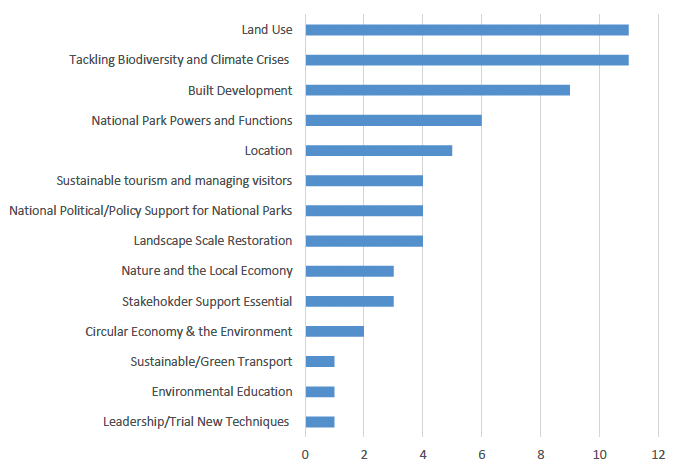
The majority of the comments focussed on the role which National Parks could play in tackling the biodiversity and climate crises and the role which land use (including built development) would need to play within the Park to achieve the ambitions. All comments received recognised the key role which National Parks could play in addressing the twin crises. The consultation highlighted a number of land use issues within National Parks, such as grazing pressure and degradation of peatlands. The ability of National Parks to contribute to biodiversity recovery at a large (landscape) scale was also highlighted as an important part of their role. The importance of the Parks ensuring the involvement of local communities and businesses in decision making associated with land management, particularly change, was recommended.
3.3 Governance, Corporate Structure and Roles for National Parks
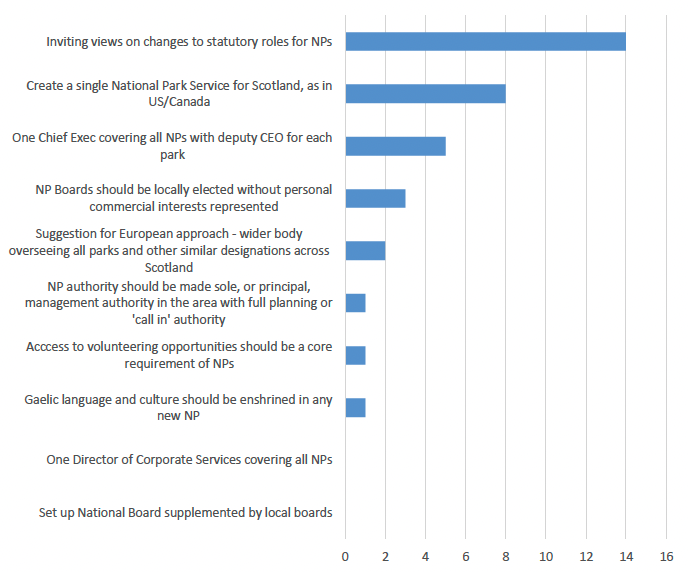
The largest number of comments in this section expressed views on changes to statutory roles for National Parks. This included some support for the creation of a National Park Service, similar to those in USA and Canada, to work across all of Scotland's National Parks. A more centralised approach was also reflected in a number of views expressing a preference for a single CEO overseeing National Parks with deputies appointed for individual parks.
There were also a number of comments related to ensuring governance and structures of National Parks take into account the local circumstances and identity and are without any vested/commercial interests. This includes clear support for local democratic representation on National Park boards.
3.4 Sustainable Tourism/Visitor Management, Travel and Accessibility
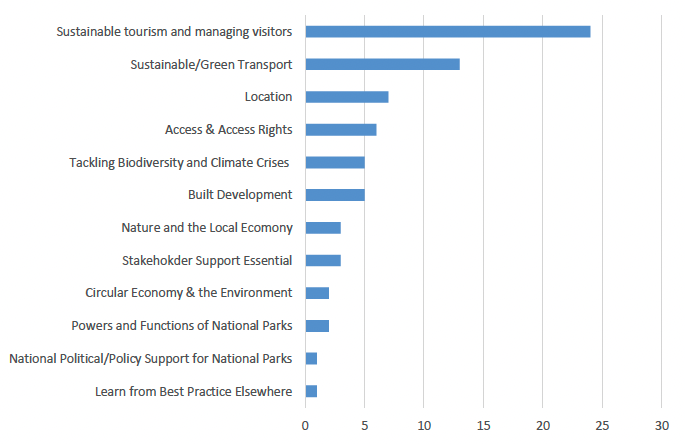
Most ideas and comments sought solutions to high visitor numbers and commented on the importance of sustainable tourism and visitor management. Increased traffic was identified as working against the nature and climate based aims of National Parks. The need for green, public transport within and in order to access parks was the idea raised most often under this theme. In particular, it was suggested that any such services should be regular, accessible, affordable (or free, where appropriate) and introduced without negatively impacting on local communities.
Accessibility in general was a key theme in the responses and ideas received in particular for those with low mobility or younger people.
Additionally, a significant number of ideas identified well-funded ranger services and improved/increased facilities as being key to successful visitor/Park management.
This section also included opposition to new National Parks, with visitor numbers/pressure, visitor behaviour and second homes among the reasons against the designation of new National Parks.
3.5 Local Economy And Impact On Communities
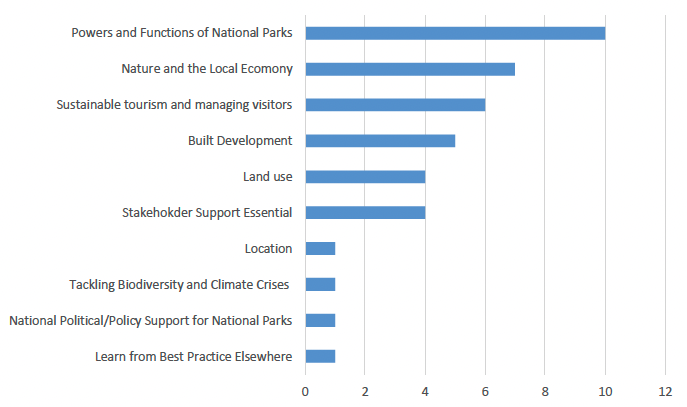
The powers and functions of National Parks were discussed by a number of respondents, covering a range of areas, including planning powers for National Park Authorities, learning from existing National Parks and the impact of National Parks being in one versus multiple local authority areas.
Second homes within the area of National Parks was also a recurring topic, with responses reflecting upon the impact on the local community and businesses.
A number of responses highlighted the importance of existing local economies and the desire to see National Parks remaining as working landscapes, acknowledging the industries and employers in place.
3.6 Land Use
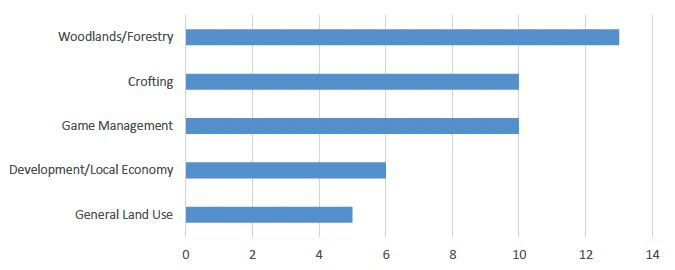
Forestry was the most common topic discussed in responses about land use, with a broad range of ideas relating to support for forestry or the opportunities a new National Park could bring. Additionally, there were also a number of responses encouraging greater restoration or expansion of ancient/natural woodland.
Crofting generated a range of comments with most responses on this topic seeking new crofting opportunities within any new National Park. A smaller number of responses expressed opposition to crofting both in the new Park and generally.
The ideas generated in relation to wildlife and game management included a range of opposing views, with calls to ban driven grouse shooting raising the most views whereas other responses sought to highlight the benefits of game management for the local economy and environment.
3.7 Climate Change and Renewable Energy

In section 11, views on the themes of climate change and renewable energy have been grouped, with renewable energy – and windfarms in particular – being the most prominent topic.
Views expressed under this topic highlight national planning policy which does not support development proposals for windfarms within National Parks. A number of respondents have commented that National Park designation would rule out future/planned windfarms, with a smaller number of respondents suggesting that windfarms should be permitted within National parks.
The impact of onshore wind developments on land, nature and communities is a common theme under this topic. Issues raised include community benefit, how to balance national priorities and needs in relation to renewable energy and the challenge of meeting Scotland's net zero commitments if windfarms are not permitted in National Parks.
There are also a significant number of comments highlighting the matter of grid connectivity and wider renewable energy considerations. These include giving consideration to planned future transmission infrastructure upgrades and network development needs being considered when planning for new parks.
Overall there is no consensus in the views expressed in relation to renewable energy.
On the theme of tackling climate change, the majority of respondents gave recognition and support for National Parks having a leading role in supporting these aims. The views expressed cover a wide range of related subject areas, including leading on sustainable land use and working to facilitate this within the park, carbon storage, working with local business and becoming an exemplar within Scotland for tackling climate change and the just transition to net zero.
Another key feature in this theme is the management and expansion of existing and ancient woodland and the key role this can play in tackling climate change. A range of views express support for this being a key role of National Parks.
3.8 Opposition Views

This section focuses on the views which expressed opposition to the topics and ideas in this dialogue exercise, in particular around the establishment of new National Parks. The views received offered a range of reasons and considerations for opposition to new NPs.
Concerns about potential additional bureaucracy and associated costs were raised by a number of respondents. There were also views expressed about the potential for additional planning restrictions and processes to remove planning control from local authorities and existing enterprise/growth initiatives. Some respondents questioned whether National Park status was needed and if other approaches may be more appropriate for protecting the natural environment.
A significant proportion of views within this section expressed concerns relating to the impact that a new National park could have on the local area, for example regarding visitor numbers/management, house price impacts on the local community and the impact on jobs. Some respondents also questioned the economic benefit that would be realised as well as whether the impacts of a new National Park on nature and biodiversity would be negative as a result.
Windfarms were also a recurring topic under this theme. Respondents' views largely centred on the challenge of meeting Scotland's net zero commitments if development of windfarms in National Parks is not supported..
Further Information:
While this paper summarises the views provided by respondents, the full list of Dialogue responses is available to view at ideas.gov.uk.
Contact
Email: biodiversity@gov.scot
There is a problem
Thanks for your feedback